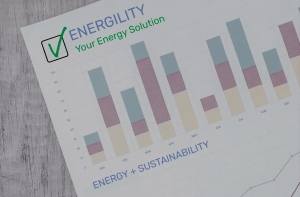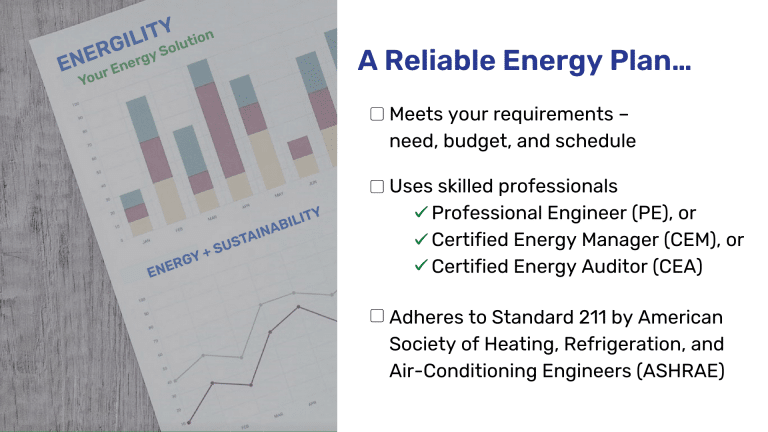
Energy audit and energy assessments are common terms used to discuss the study of energy use in a building; some organizations use the terms interchangeably and some have very specific definitions for both. At Energility, we prefer to use the term “Energy Plan” when discussing our findings to clients. So, what is the difference?
An energy audit refers to a review of past utility bills and a site survey with recommendations on energy conservation and/or energy efficiency measures. An audit is a review of the facility’s operations and opportunities for improvement. There are statistical analyses of energy sources, observation on current conditions of equipment, and review of operating characteristics of the building (is the equipment inefficient or is the building lighting on 24 hours a day) to show where to recommend energy conservation or energy efficiency measures. An energy audit is usually more analytical than an assessment.
An energy assessment is a walk-through where observations are made based on spot checking of current conditions of the building, the equipment, and the operations. A review of utility bills may be conducted to determine potential savings opportunities. An energy assessment usually takes less time than an energy audit.
For some funding opportunities, a utility or a financing agency may require an energy study (audit or assessment) and they may have specific requirements related to analysis, recommendations, recording, or specific criteria in order to receive their funding. American Society of Heating and Refrigeration and Air Conditioning Engineers (ASHRAE) Standard 211 is the commercial building energy audit standard for criteria of what gets included in the audit and how reports are formed. Each subsequent level requirement is collecting increasingly more detail and reporting more detailed findings. A level 1 report has minimal substance but a level 2 report is typically the requirement for utility rebates or financing. Level 3 reporting requires design details including schematics, sequences of operations, etc. It is interesting to note that Standard 211, the energy audit standard, also references the word “assessment” 34 times.
Energility delivers an Energy Plan for our clients to report the findings from the energy audit. We use a combination of statistical analysis, engineering methodology and calculation, observation and assessment of current building operations, equipment condition, and space use. We use equipment to collect spot data while we are on site, and we use data loggers to collect information over time like occupancy, temperature, humidity, and other building characteristics. Our analysis methodology takes into account a normal year of operations, both weather and occupancy, so that they can have an expectation of accurate savings regardless of when the project is implemented. Energy Plans are written to show our clients our findings in a way that is easy to understand and with energy conservation and energy efficiency measures. We call it an “Energy Plan” because our clients are typically looking at how to assess the condition of their entire building and what improvements can be done that fit both their needs and budget. This is why we recommend measures from immediate, low cost items to future capital improvements.
Even though energy audits and energy assessments are different terms, both are looking at ways you can save energy and save money. An Energy Plan is customized to fit the client’s needs and budget. This can range from an assessment or simple audit to an in depth audit including a review of feasibility of on-site generation of renewable energy and design.

There are resources for commercial properties to decide what is right for them.
Homeowners can use the ENERGY STAR® website to either do a walkthrough of their own house or hire someone to assess their current energy use. Many electric and gas utilities offer low-cost home energy audits where an auditor will assess current opportunities and make recommendations or even conduct the installation of measures (i.e., new thermostat, insulation, etc).